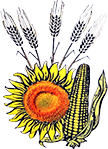Studies on Biodiversity Conservation of Cowpea Plant Resources in Sandy Soil Conditions in Southern Oltenia
Reta Drăghici, Alina Nicoleta Paraschiv, Milica Dima
Stațiunea de Cercetare-Dezvoltare pentru Cultura Plantelor pe Nisipuri Dăbuleni
Keywords: drought, cowpea germplasm, biology, productivity, type of plant growth.
Abstract: Research conducted during 2016-2021 at Research and Development Station for Plant Culture on Sandy Soils, Dăbuleni on the conservation of biodiversity of traditional cowpea plant resources has shown a great variability of biological and morphological characteristics that can be used in the future in the process of improving existing varieties. A number of 130 cowpea genotypes (Vigna unguiculata L. Walp) were studied, during which the vegetation period took place during 84-116 days, in conditions of an average air temperature of 22.4°C. The grain production obtained in the germplasm collection in cowpea was between 928.6-3164.3 kg/ha, with an average of 2239.3 kg/ha, being marked significantly positively correlated with the number of pods per plant (r=0.683**) and distinctly significant negative with disease resistance (r=-0.376oo). The type of plant growth allows the selection and use of cowpea biotypes in the process of plant improvement depending on the desired variety.
Out of the total of 130 genotypes studied, 46.9% allow the selection for obtaining varieties for grains, 33.1% allow the selection of cowpea genotypes for fodder, and 20% allow the selection for obtaining genotypes for green manure. Due to the biological properties of the plant, regarding the increased resistance to drought and the reduced requirements for soil fertility, cowpea can be a good alternative for growing beans and soybeans, plants very sensitive to stressors in areas with excessive drought. In this sense, the analysis of the physiological behavior of four cowpea genotypes (Jiana, Aura 26, Ofelia, Doljana) underlined a diurnal variation of the physiological processes, in the conditions of recording, at the level of the leaf, some temperatures of 32.8-33.1°C (at 9 o'clock), 39.8-40°C (11:30 o'clock) and 45.1-46.4°C (15:30 o'clock) and an active solar radiation between 1290-1760 µmol/m2/s. Thus, a distinctly significant correlation was established between photosynthesis and solar radiation, which shows the tendency to decrease the intensity of photosynthesis with the increase of solar radiation over the value of 1600 µmol/m2/s. The degree of opening of the stomata is an important indicator of the response of plants to thermohydric stress, and the results obtained in cowpea showed that the variation of stomatal conductance, in the range 0-0.19 mol H2O/m2/s, directly influenced the rate of photosynthesis (0.20-21.5 µmol CO2/m2/s) and the rate of foliar perspiration (0.36-4.2 mmol H2O/m2/s). The statistical analysis of the obtained results highlighted the distinctly significant positive correlation of the stomatal conductance with the photosynthesis process (r=0.935**) and with the foliar perspiration process (r=0.663**).
